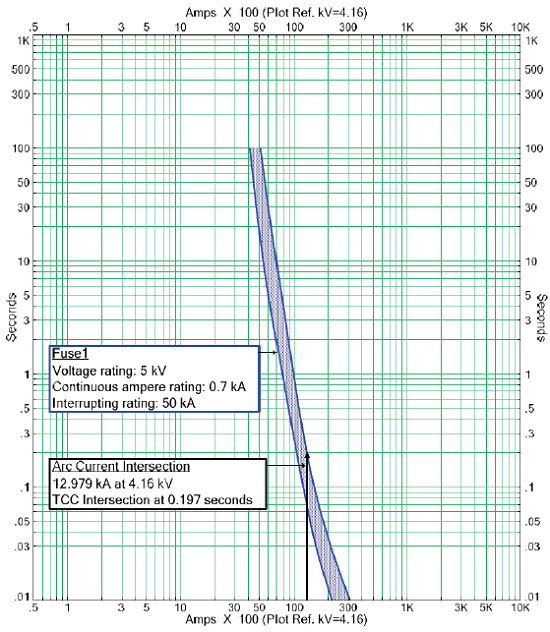Related Resources: calculators
Determination of the Arc Duration per IEEE 1584-2018
Electrical and Electronics Design and Engineering
Determination of the Arc Duration per IEEE 1584-2018
Related:
Arc Flash Hazard Calculations Procedure and Considerations For Medium Voltage System
Determining how long an arc flash could last is the most important piece of information in predicting its severity. The duration is usually dependent on how fast an upstream protective device will trip. The longer it takes, the greater the incident energy and resulting hazard. Typically, Time Current Curves (TCC) of the circuit overcurrent protection devices is used.
Fuses: information from the manufacturer’s time-current curves should be used. These curves may include both melting and total clearing time. If both are available, the total clearing time that represents the worst-case duration should be used. If the curve only consists of the average melt time, 10% of time plus an additional 0.004 s should be added to determine the total clearing time. If the total clearing time at the arcing fault current is less than 0.01 s, then 0.01 s may be used for the time. For current-limiting fuses, if the arcing current is greater than the current-limiting threshold [obtained from the peak let-through (peak let-thru) curves], then use the manufacturer’s recommendation on the total clearing time and effective arc current.
Low-voltage circuit breakers: For low-voltage circuit breakers with integral trip units, the manufacturer’s time-current curves include both the device tripping time and clearing time in most cases. Note that some low-voltage power circuit breakers may be equipped with retrofit trip units. The time-current curves included with the replacement trip unit may, or may not, include the circuit breaker operating time. If the curves show only the trip unit’s operating time, a circuit breaker operating time (typically 0.05 s or three cycles) should be added.
Overcurrent relays and circuit breakers: The manufacturer(s) of the protective relay(s) and circuit breaker(s) should be consulted for detailed information regarding the operating characteristics and time-current curves. For protection schemes using overcurrent protective relays and circuit breakers, the relay time-current curves illustrate the relay operating time. The circuit breaker interrupting time is added to the relay operating time plus any additional time delays such as for lockout-relays, manufacturer’s tolerance, and other additional time delay considerations. Circuit-breaker interrupting times can be verified by consulting the manufacturer’s literature or the circuitbreaker nameplate data. Interrupting time is the sum of the circuit-breaker opening time and arcing time. See IEEE Std C37.010-2016 and IEEE Std 551-2006 for additional information.
The arc duration is defined as the time it takes the upstream energizing source(s) of arcing current to stop providing current or energy to the arc fault. Typically, the clearing time of overcurrent protective devices depends on the magnitude and/or direction of the arc current passing through their current sensing equipment (current transformers, relays, etc.). When multiple sources are present, the arc duration depends on the time it takes the last protective device to clear the arc current. Under special circumstances, the arc duration is not totally dependent on protective device opening or trip time, but also on the time it takes the stored energy to be discharged through the arc. Examples of this condition include, but are not limited to, faults near generator terminals on the line side of the generator circuit breaker.
Example"
Figure T below shows how the arc duration would be obtained from a sample MV power fuse time current characteristic (TCC) curve.
Typically, after calculating the Final Arcing Current an electrical component Current Characteristic Curve (TCC) is obtained the the arc duration is determined.
The final arcing current may be calculated from the Interpolation Arcing Current Equations and Calculator.
Assuming:
Iarc = 12.979 kA at 4.16 kV,
TCC intersection Arc time = 0.197 seconds or 197 ms

Figure T